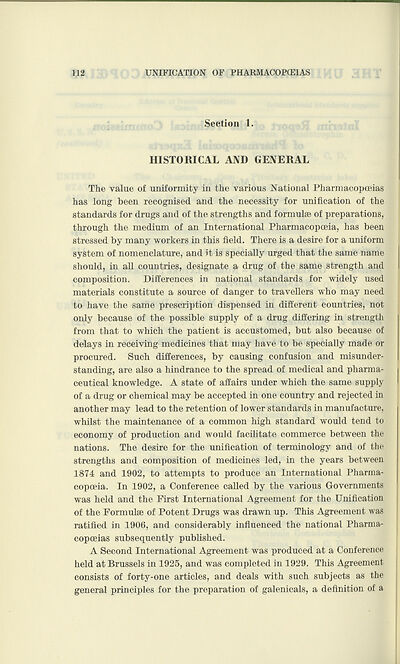Download files
Complete book:
Individual page:
Thumbnail gallery: Grid view | List view

112
UNIFICATION OF PHARMACOPCEIAS
...
Section 1.
HISTORICAL AND GENERAL
The value of uniformity in the various National Pharmacopeias
has long been recognised and the necessity for unification of the
standards for drugs and of the strengths and formulae of preparations,
through the medium of an International Pharmacopeia, has been
stressed by many workers in this field. There is a desire for a uniform
system of nomenclature, and it is specially urged that the same name
should, in all countries, designate a drug of the same strength and
composition. Differences in national standards for widely used
materials constitute a source of danger to travellers who may need
to have the same prescription dispensed in different countries, not
only because of the possible supply of a drug differing in strength
from that to which the patient is accustomed, but also because of
delays in receiving medicines that may have to be specially made or
procured. Such differences, by causing confusion and misunder¬
standing, are also a hindrance to the spread of medical and pharma- i
ceutical knowledge. A state of affairs under which the same supply I
of a drug or chemical may be accepted in one country and rejected in
another may lead to the retention of lower standards in manufacture,
whilst the maintenance of a common high standard would tend to
economy of production and would facilitate commerce between the
nations. The desire for the unification of terminology and of the
strengths and composition of medicines led, in the years between
1874 and 1902, to attempts to produce an International Pharma¬
copoeia. In 1902, a Conference called by the various Governments
was held and the First International Agreement for the Unification
of the Formulse of Potent Drugs was drawn up. This Agreement was
ratified in 1906, and considerably influenced the national Pharma¬
copoeias subsequently published.
A Second International Agreement was produced at a Conference
held at Brussels in 1925, and was completed in 1929. This Agreement
consists of forty-one articles, and deals with such subjects as the
general principles for the preparation of galenicals, a definition of a
UNIFICATION OF PHARMACOPCEIAS
...
Section 1.
HISTORICAL AND GENERAL
The value of uniformity in the various National Pharmacopeias
has long been recognised and the necessity for unification of the
standards for drugs and of the strengths and formulae of preparations,
through the medium of an International Pharmacopeia, has been
stressed by many workers in this field. There is a desire for a uniform
system of nomenclature, and it is specially urged that the same name
should, in all countries, designate a drug of the same strength and
composition. Differences in national standards for widely used
materials constitute a source of danger to travellers who may need
to have the same prescription dispensed in different countries, not
only because of the possible supply of a drug differing in strength
from that to which the patient is accustomed, but also because of
delays in receiving medicines that may have to be specially made or
procured. Such differences, by causing confusion and misunder¬
standing, are also a hindrance to the spread of medical and pharma- i
ceutical knowledge. A state of affairs under which the same supply I
of a drug or chemical may be accepted in one country and rejected in
another may lead to the retention of lower standards in manufacture,
whilst the maintenance of a common high standard would tend to
economy of production and would facilitate commerce between the
nations. The desire for the unification of terminology and of the
strengths and composition of medicines led, in the years between
1874 and 1902, to attempts to produce an International Pharma¬
copoeia. In 1902, a Conference called by the various Governments
was held and the First International Agreement for the Unification
of the Formulse of Potent Drugs was drawn up. This Agreement was
ratified in 1906, and considerably influenced the national Pharma¬
copoeias subsequently published.
A Second International Agreement was produced at a Conference
held at Brussels in 1925, and was completed in 1929. This Agreement
consists of forty-one articles, and deals with such subjects as the
general principles for the preparation of galenicals, a definition of a
Set display mode to:
![]() Universal Viewer |
Universal Viewer | ![]() Mirador |
Large image | Transcription
Mirador |
Large image | Transcription
Images and transcriptions on this page, including medium image downloads, may be used under the Creative Commons Attribution 4.0 International Licence unless otherwise stated. ![]()
| League of Nations > Health > Bulletin of the Health Organisation > Volume 11 > (356) |
|---|
| Permanent URL | https://digital.nls.uk/202635402 |
|---|
| Attribution and copyright: |
|
|---|---|
| Description | League of Nations |
|---|---|
| Shelfmark | LN.III.12.(2) |
| Shelfmark | LN.III |
|---|---|
| Description | Over 1,200 documents from the non-political organs of the League of Nations that dealt with health, disarmament, economic and financial matters for the duration of the League (1919-1945). Also online are statistical bulletins, essential facts, and an overview of the League by the first Secretary General, Sir Eric Drummond. These items are part of the Official Publications collection at the National Library of Scotland. |
|---|---|
| Additional NLS resources: |
|

